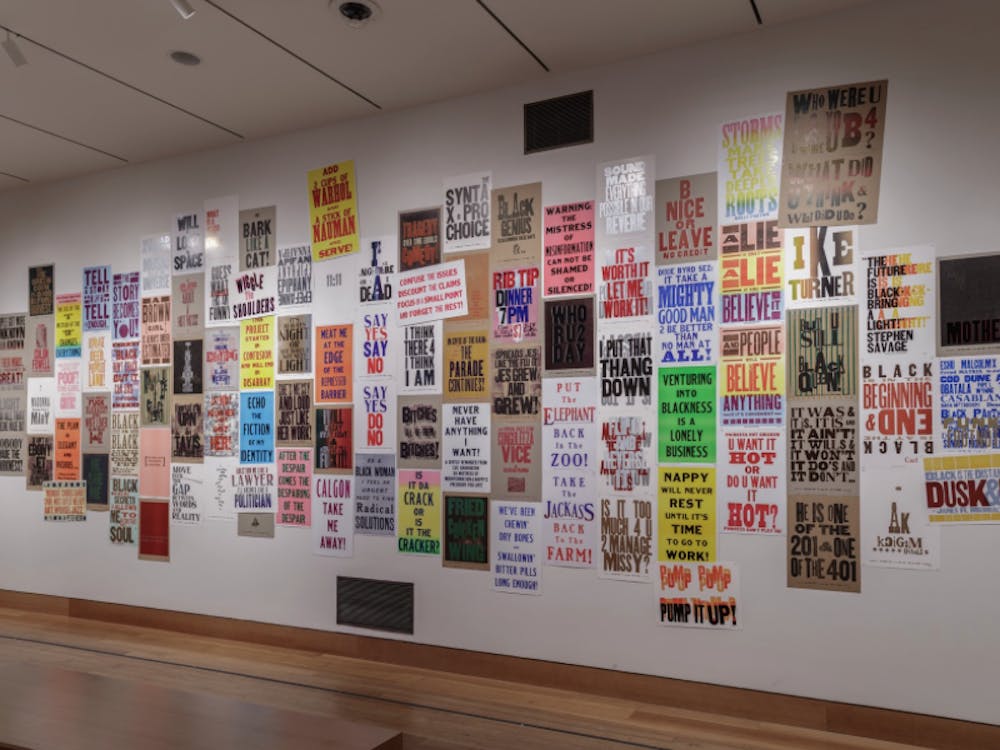Indianapolis-born artist Carl Robert Pope Jr.’s “The Bad Air Smelled of Roses,” a collection of more than 108 posters, speaks for itself. Set against a rainbow of vivid backgrounds, terse quotes like “The Future is Black - Bring a Light!” and “A Brown Girl is Always Underestimated” seem to beam off of the page.
The project, described as an “ongoing essay about the presence and function of Blackness in society,” originally began in 2004 and will add 22 new pieces this spring for an on-campus installation in early April.
Students in Bill Fick’s “Poster Design and Printing” course will complete the project, screen-printing the posters in Pope’s style and wheatpasting them onto The Rubix, a pop-up installation space on campus. Pope, a virtual visiting artist this semester, will Zoom into Fick’s class to offer support and guidance throughout the project. Pope created 22 new slogans for the class to work with, allowing students to take charge of the design.
“What I'm excited about is that the students will be able to sort of get into [Pope’s] mind and understand how he creates his text and what he's thinking and how he sees that as being an effective tool to convey the message that he wants to convey,” said Fick, a lecturing fellow in the Department of Art, Art history and Visual Studies. “And visually, it's really going to be something else. I mean, just thinking about a structure that’s totally covered with text — it’s going to be super exciting. Even just looking at it from a distance, I think it’s going to have a lot of impact.”
Pope first interacted with Duke this academic year through the Franklin Humanities Institute’s Social Practice Lab, directed by Art, Art History and Visual Studies professor Pedro Lasch. After Lasch invited Pope to speak to his lab, Fick recalled talking to Lasch about how “cool” it would be to further engage Pope’s work on campus. Right before the start of the spring semester, Fick proposed the poster design course, exposing students to renowned poster artists like Pope, Corita Kent and Barbara Kruger as well as providing them firsthand screen-printing experience.
“Especially during these times, I think it's a nice opportunity for students to not have to be in their apartments or dorm rooms — I think just being physical with a creative process is just a really nice thing right now,” Fick said. “I think exposing the students to this kind of work and this process is really exciting because they might end up saying, ‘Hey, you know, I want to do something like that, too.’”
The installation will also be The Rubix’s first involving student work. Established in early 2020 by Fick and fellow Art, Art History and Visual Studies lecturer Stephen Hayes, the wooden structure was meant to serve as a pop-up exhibition space as well as an art piece in itself, probing questions about the nature of public art. Last spring, Fick taught a different course that was also centered around creating an installation for the space, but the COVID-19 pandemic derailed those plans. From November 2020 until early this month, The Rubix displayed Antoine Williams’ audio collage “Othered Suns”, but students were unable to be involved with that project.
“Really, the only reason we created it is that really there are no spaces on campus … where you can actually put art onto a structure or modify the structure. The only space that is sort of like that is the tunnel heading to East Campus, which is really a free-for-all,” Fick said. “So yeah, it’s a unique structure on campus to where we could, you know, cover it with posters and not have it be a problem.”
According to Fick, merely finding a place where art for art to be seen in person is difficult in the age of COVID, as traditional venues like museums and stages have largely been shut down. However, the public exposure aspect remains critical for works like Pope’s that are centered on social justice. The slogans Pope created for the class engage themes like the Black Lives Matter movement, Black history and Black culture.
“It's just a really important time to be doing work like this. I think there's even been a call from the university for classes to deal with these social justice issues, and so I thought this would just be a really perfect class for that,” Fick said.
The public nature of both The Rubix and posters as a medium made the space an ideal home for the Pope installation. Despite having “a gigantic campus with plenty of open spaces,” Fick noted a lack of sculptures on campus beyond the bronze statues of Duke family members that adorn the quads.
“I think this allows us to really investigate what kind of public art we can do on campus. I mean, obviously, you know, the university wants things to be tasteful … but I mean, I think we’ve got plenty of room,” Fick said. “You know, does it allow us to think that maybe we could do more? I don't know. I think there might be an opportunity … with COVID sort of allowing us to think that way. Before, we were pretty much always thinking about things on the inside, but I think now having stuff on the outside is really important. Because otherwise, there's no art anywhere.”
Get The Chronicle straight to your inbox
Signup for our weekly newsletter. Cancel at any time.

